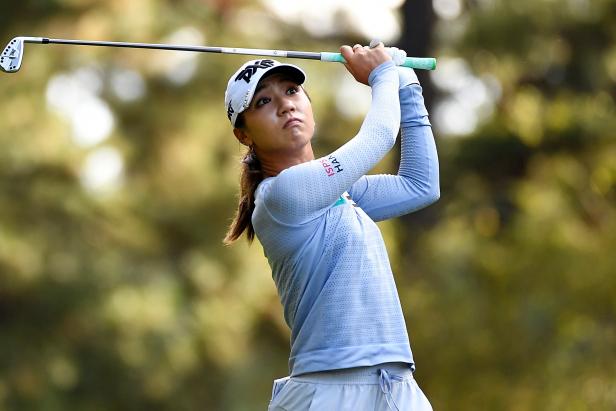HOUSTON—Sean Foley has taken on his share of reclamation projects (see: Woods, Tiger and Willett, Danny, among others). Now the man with the Bob Marley verse “None but ourselves can free our mind” tattooed on his arm, is in the midst of another one: Lydia Ko.
Just five years ago, Ko was a tour de force on the LPGA. At age 17, she became in February of 2015 the youngest player to reach No. 1 in the world. Six months later, at age 18, she was the youngest woman to win a major championship at the Evian Championship. By 19, she was a two-time major champion and a silver medalist at the 2016 Rio Olympics.
Her accomplishments didn’t rival that of a young Woods or Jack Nicklaus—they surpassed them. The phenom was living up to her billing and then some after having become at age 15 the youngest player to win on the LPGA Tour when she captured the CN Canadian Women’s Open in 2012.
Ko also played the game with youthful exuberance and joy and, at just 5-foot-5 and not terribly long off the tee, she possessed a style that was more van Gogh than Michelangelo, with a short game that was pure artistry.
There were, however, warning signs that it might not last.
Ko changed caddies eight times—in her rookie year alone. The same pattern was true with coaches—Guy Wilson, David Leadbetter, Gary Gilchrist, Ted Oh, David Whelan and Jorge Parada were all hired and fired in a parade of quizzical moves.
Other changes occurred, too. In the fall of 2018, Ko dyed her hair platinum blonde at the urging of friends Michelle Wie and Allison Lee. She had also become noticeably thin, having dropped 15 pounds, and at the ANA Inspiration in April of 2019 Juli Inskter cracked on Golf Channel that it looked like Ko “needs to go to the buffet counter a little bit,” while analyst Judy Rankin followed with, “We all want to see five more pounds on Lydia.”
Her once-dazzling game, so fluid and effortless, eventually began to slip, too. The constant changes (caddies, coaches, equipment) chipped away at her confidence and an over-analyzation of her swing short circuited her thoughts. Ko hasn’t won a tournament since 2018 and earlier this season she fell outside the top 50 in the world ranking for the first time since her first year as a professional.
Ko, who also lives in Orlando, first reached out to him more than a year ago.
Not long after, Ko was back to being a brunette, watching a handful of videos of her swing from the height of her powers and trying to work her way back to that form. This year, the COVID-19 pandemic only accelerated her progress and 5 1/2 months ago she called Foley again and told him that she thought she was ready. The next morning the two went to work at Isleworth.
“The goal was to get her to understand her swing, how it works, why it works and to get her to hit that baby fade,” Foley said.
The other goal was to make the game fun again, which is why Foley, among other things, gave his pupil various games to play while practicing on the course—teeing it up from the back tees with no woods, playing the forward tees with driver, playing a worst-ball round, intentionally hitting every approach into a greenside bunker.
“The other goal was to get her to enjoy the game and the creativity of it again,” he said. “She’s so creative. She’s brilliant. But here was a girl who was looking at videos and numbers. That’s not her.”
All of which perhaps explains the upward trend in her recent results as she arrives for this week’s U.S. Women’s Open at Champions Golf Club.
In her last 10 starts, Ko has finished in the top 15 on seven occasions, including in August’s Marathon LPGA Classic, where she finished second, and at last month’s Pelican Women’s Championship, where she tied for fourth in her last start before heading to Houston. She also finished sixth at the ANA Inspiration in September for her best result in a major since a T-3 at the 2017 Evian.
“I’ve been looking at lots of my videos or swing videos,” Ko said at the LPGA Drive On Championship in October. “Kind of weird to Google or YouTube yourself, but I’ve been doing that to just see my swing as an amateur.
“[Foley] I think has gotten me not to think too much about the lines of everything. I’ve tried to change my mindset of not trying to take a video of my swing every single time I’m on the driving range. … It doesn’t need to look like a perfect swing for me to just play golf.”
There have been some technical adjustments, too, although nothing close to a major overhaul. Instead, Ko simply adjusted her distance from the ball, worked on alignment and has tried to make the arc in her swing as big as it can get.
“That’s it,” Foley said.
Ko has also put on 13 pounds of muscle, added 12 mph in clubhead speed and introduced a small waggle to her routing before pulling the trigger. Perhaps most importantly, she no longer obsesses over every swing or shot.
“When we first started, she had 50 questions a day,” Foley said. “There’s no questions left. In 5 1/2 months together, she’s seen her swing twice. She used to video every shot.”
And while this week marks the final major of the year, it’s hardly an end point for Ko. Rather, it’s simply another step toward returning to the top of the game.
It’s also worth reminding that Ko still is just 23 years old.
“Maybe she’ll be the best in the world again, maybe she won’t,” Foley said. “The danger is that you get so good so quickly that when you lose it, you don’t remember how you did it in the first place.”
But for Ko, she’s simply enjoying the journey and the process of figuring it out.

